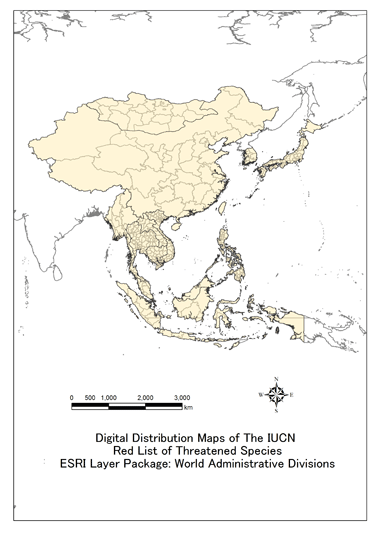
TOP > 生物多様性センターの国際協力 > ESABII > Database > Threatened Mammal Species Database > Macaca pagensis

Macaca pagensis
Taxonomy (Name)
| Class | MAMMALIAIUCN | |
|---|---|---|
| Order | DIPROTODONTIAIUCN | |
| Family | CERCOPITHECIDAEIUCN | |
| Scientific Name | Macaca pagensisIUCN | |
| Author | (Miller, 1903)IUCN | |
| Synonyms | Macaca mentaveensis de Beaux, 1923IUCN | |
| Common Name | Pagai Island Macaque, Pagai MacaqueIUCN | |
| Local name | Brunei Darussalam | |
| Cambodia | ||
| China | ||
| Indonesia | Bokoi, Beruk Mentawai | |
| Japan | ||
| Lao PDR | ||
| Malaysia | ||
| Myanmar | ||
| Mongolia | ||
| Philippines | ||
| Singapore | ||
| Republic of Korea | ||
| Thailand | ||
| Vietnam | ||
Picture
Distribution, Range
This species occurs exclusively on the southern Mentawai Islands off the west coast of Sumatra, Indonesia (Pagai Selatan, Pagai Utara, and Sipora) (Roos et al. 2003).
Map


Country
| Brunei Darussalam | |
|---|---|
| Cambodia | |
| China | |
| Indonesia | |
| Japan | |
| Lao PDR | |
| Malaysia | |
| Myanmar | |
| Mongolia | |
| Philippines | |
| Singapore | |
| Republic of Korea | |
| Thailand | |
| Vietnam |
Status
International Status
IUCN Red List Category
CRIUCN
Justification
This species is considered Critically Endangered due to a past and continued population decline, estimated at more that 80% over the past 40 years (3 generations), due to hunting and loss of habitat.
CITES
Appendix IIIUCN
CMS
National Status
| Country | Category | Reference |
|---|---|---|
| Brunei Darussalam | ||
| Cambodia | ||
| China | ||
| Indonesia | ||
| Japan | ||
| Korea | ||
| Lao PDR | ||
| Malaysia | ||
| Mongolia | ||
| Myanmar | ||
| Philippines | ||
| Singapore | ||
| Thailand | ||
| Vietnam |
Ecology Discription
Appearance
Habitat
This species is found in both primary and disturbed areas (Whitten and Whitten 1982; Fuentes 1996/1997), preferring primary riverine coastal swamp forest (Wilson and Wilson 1976).
Population size
All populations of this species are urgently in need of protective measures (Whittaker 2006). The most recent estimates of density for it suggest 7-12 individuals/km2 in suitable habitat in the Pagai Islands (Paciulli 2004), giving a total of about 2,100 to 3,700 individuals (down from 15,000 in 1980) (Whittaker 2006). This species lives at much higher densities in logged forest than in unlogged forest, and their highest density is in forest logged 20 years ago (Whittaker 2006).
Behavior
Diet
It is primarily frugivorous (Whitten and Whitten 1982).
Reproduction
Threat
Major Threat(s)
This species is threatened mainly by hunting and commercial logging (Whittaker 2006), as well as by conversion to oil palm plantations and forest clearing and product extraction by local people (Whittaker 2006). Only 10-15% of the original forest cover remains on Sipora (Fuentes 1996/1997). Recently, hunting pressure has increased because of improved access to remote areas due to logging roads and tracks, as well as the replacement of bows and arrows with .177 caliber air rifles (anything larger is illegal in Indonesia) (Whittaker 2006). Also, local rituals and taboos that formerly regulated hunting have been replaced by Christianity (Whittaker 2006). The pet trade is also a threat to this species (Whittaker 2006). Though this species is not a preferred food item, it is still hunted and poisoned as it is considered a crop pest (Whittaker 2006). While habitat disturbance appears to positively affect population densities, it is found in lower densities near human settlements (Whittaker 2006).
Conservation and Measurement
International
It is listed on CITES Appendix II.IUCN
National
The species does not occur in any protected areas. Whittaker (2006) suggests the following conservation actions: protection of areas in the Pagai Islands by cooperating with a logging corporation that has practiced sustainable logging technique there since 1971; conservation education, especially regarding hunting; and the development of alternative economic models for the local people, to reduce the likelihood of selling off their lands to logging companies.
Conservation law
| Country | Status | Reference |
|---|---|---|
| Brunei Darussalam | ||
| Cambodia | ||
| China | ||
| Indonesia | Protected Animals | Goverment Regulation no. 7 / 1999, about Preservation of Plants and Animals |
| Japan | ||
| Korea | ||
| Lao PDR | ||
| Malaysia | ||
| Mongolia | ||
| Myanmar | ||
| Philippines | ||
| Singapore | ||
| Thailand | ||
| Vietnam |
Protected Area
Other Coservation Projects
Citation
Fuentes, A. 1997. Current status and future viability for the Mentawai primates. Primate Conservation 17: 111-116.
Fuentes, A. and Olson, M. 1995. Preliminary observations and status of the Pagai macaque. Asian Primates 4(4): 1-4.
Groves, C. P. 2001. Primate taxonomy. Smithsonian Institution Press, Washington, DC, USA.
Kitchener, A. C. and Groves, C. P. 2002. New insight into the taxonomy of Macaca pagensis of the Mentawai Islands, Sumatra. Mammalia 66: 533-542.
Paciulli, L. 2004. The effects of logging, hunting, and vegetation on the densities of the Pagai, Mentawai Islands primates. Thesis, State University of New York.
Roos, C., Ziegler, T., Hodges, J. K., Zischler, H. and Abegg, C. 2003. Molecular phylogeny of Mentawai macaques: taxonomic and biogeographical implications. Molecular Phylogenetics and Evolution 29(1): 139-150.
Whittaker, D. 2006. A conservation action plan for the Mentawai primates. Primate Conservation 20: 95-105.
Whitten, A. J. and Whitten, J. E. J. 1982. Preliminary observations of the Mentawai macaque on Siberut Island, Indonesia. International Journal of Primatology 3: 445-459.
Wilson, C. C. and Wilson, W. L. 1977. Behavioral and morphological variation among primate populations in Sumatra. Yearbook of Physical Anthropology 20: 207-233.
